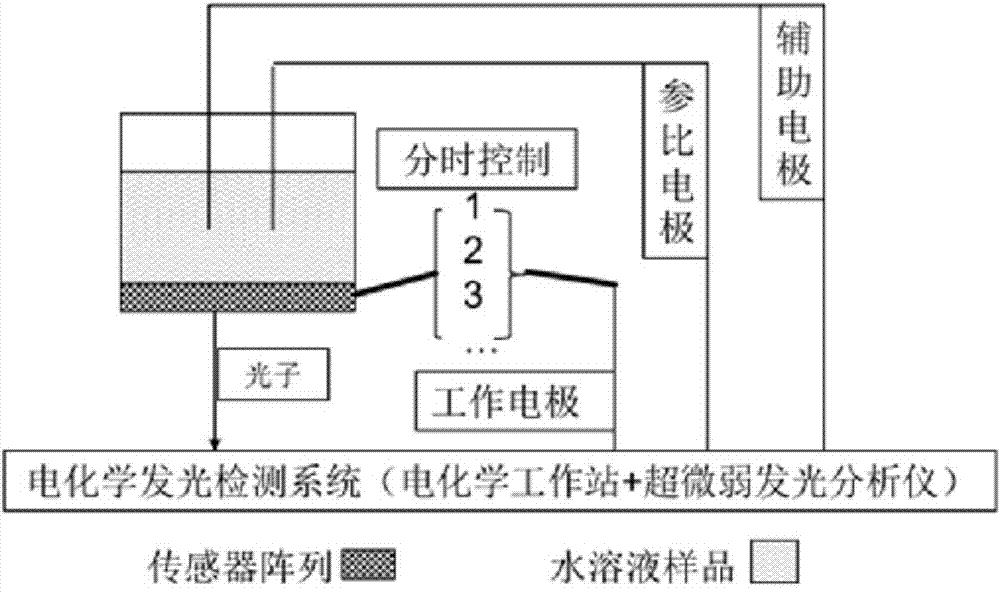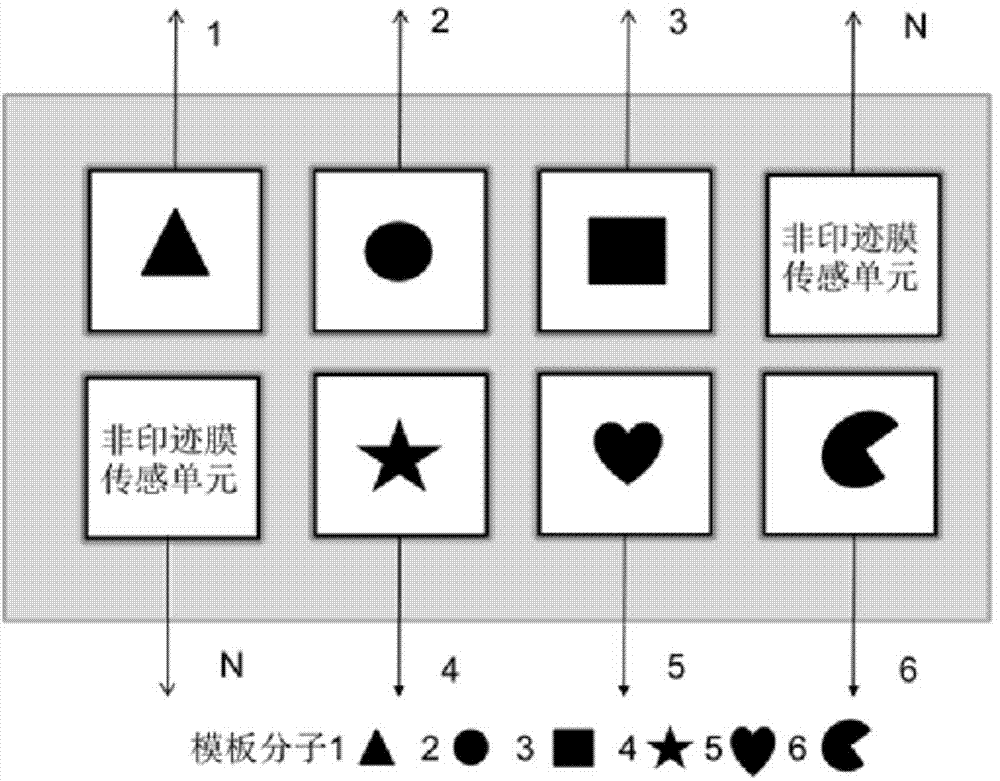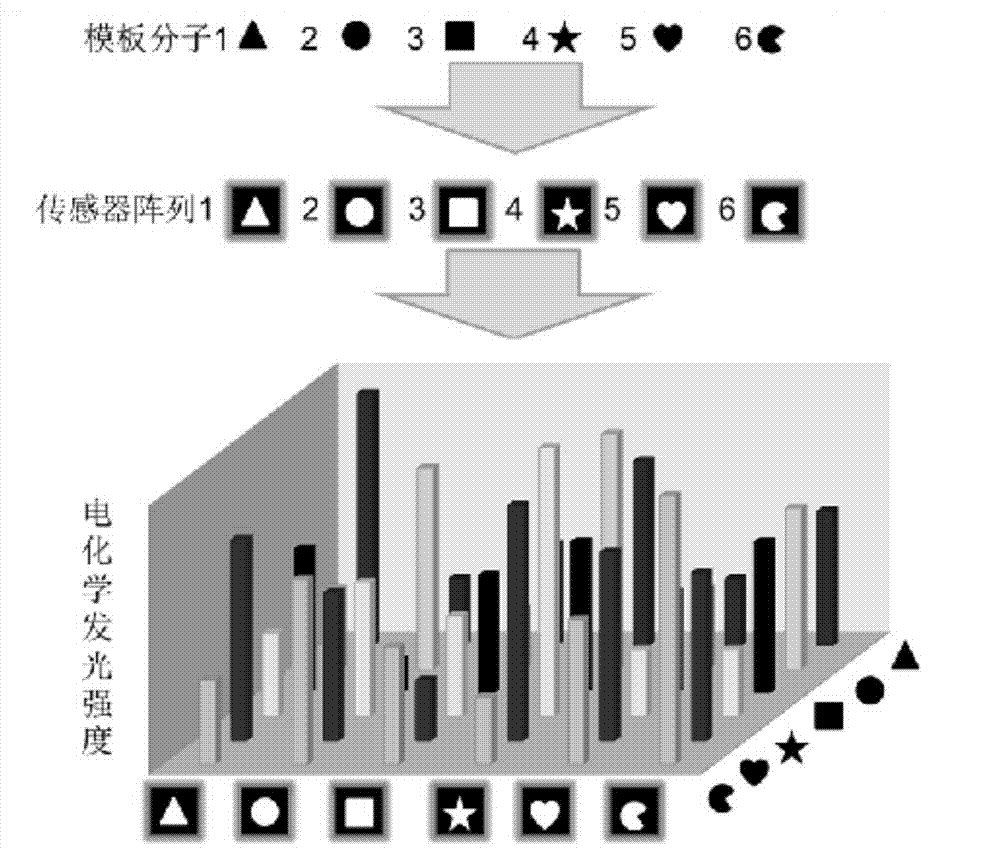Electrochemical luminescence sensor array, and preparation method and application thereof
A sensor array and electrochemical technology, applied in the field of environmental monitoring and analytical chemistry, can solve the problems of rapid detection of multiple structural analogs, inability to fully identify, single target analyte, etc., and achieve easy control and automation, strong use value, simple and convenient operation
- Summary
- Abstract
- Description
- Claims
- Application Information
AI Technical Summary
Problems solved by technology
Method used
Image
Examples
Embodiment 1
[0033] 1.1 Fabrication of electrochemiluminescent sensor arrays, such as figure 2 Shown:
[0034] The first step is to use a square ITO quartz glass electrode with a side length of 6cm as the substrate, divide the conductive layer of the substrate into 8 square electrode units with a side length of 4mm, and lead out wires to form 8 sensing units.
[0035] In the second step, the sensing unit is composed of a synthetic sex hormone sensing unit and two blank sensing units, in which template molecules, methacrylic acid, ethylene glycol dimethacrylate, dimethylformamide and benzoin ether are massaged The molar ratio is 1:4:8:15:1 and mixed evenly to make a reaction solution. Take 10 μL of the reaction solution and drop-coat it on a clean and dry ITO quartz glass electrode unit, and irradiate it with a 500W ultraviolet lamp at a distance of 30cm for 30 minutes to complete the polymerization. Molecularly imprinted sensing membrane, using 30 mL of ethanol-acetic acid-deionized wate...
Embodiment 2
[0045] 2.1 Preparation of electrochemiluminescence sensor array:
[0046] The first step is to use a square ITO quartz glass electrode with a side length of 2 cm as the substrate, divide the conductive layer of the substrate into six square electrode units with a side length of 4 mm, and lead out wires to form six sensing units.
[0047] In the second step, the sensing unit is composed of a synthetic sex hormone sensing unit and two blank sensing units, in which template molecules, methacrylic acid, ethylene glycol dimethacrylate, dimethylformamide and benzoin ether are massaged The molar ratio is 1:5:9:16:1 and mixed evenly to make a reaction solution. Take 15 μL of the reaction solution and drop-coat it on a clean and dry ITO quartz glass electrode unit, and irradiate it with a 550W ultraviolet lamp at a distance of 30cm for 30 minutes to complete the polymerization. Molecularly imprinted sensing membrane, using 30 mL of ethanol-acetic acid-deionized water mixed solvent with...
Embodiment 3
[0057] 3.1 Preparation of electrochemiluminescence sensor array:
[0058] The first step is to use a square ITO quartz glass electrode with a side length of 3 cm as the substrate, divide the conductive layer of the substrate into six square electrode units with a side length of 4 mm, and lead out wires to form six sensing units.
[0059] In the second step, the sensing unit is composed of a synthetic sex hormone sensing unit and two blank sensing units, in which template molecules, methacrylic acid, ethylene glycol dimethacrylate, dimethylformamide and benzoin ether are massaged The molar ratio is 1:3:7:13:1 and mixed evenly to make a reaction solution. Take 12 μL of the reaction solution and drop-coat it on a clean and dry ITO quartz glass electrode unit, and irradiate it with a 450W ultraviolet lamp at a distance of 25cm for 25 minutes to complete the polymerization. Molecularly imprinted sensing membrane, using 30 mL of ethanol-acetic acid-deionized water mixed solvent with...
PUM
 Login to View More
Login to View More Abstract
Description
Claims
Application Information
 Login to View More
Login to View More - R&D
- Intellectual Property
- Life Sciences
- Materials
- Tech Scout
- Unparalleled Data Quality
- Higher Quality Content
- 60% Fewer Hallucinations
Browse by: Latest US Patents, China's latest patents, Technical Efficacy Thesaurus, Application Domain, Technology Topic, Popular Technical Reports.
© 2025 PatSnap. All rights reserved.Legal|Privacy policy|Modern Slavery Act Transparency Statement|Sitemap|About US| Contact US: help@patsnap.com



